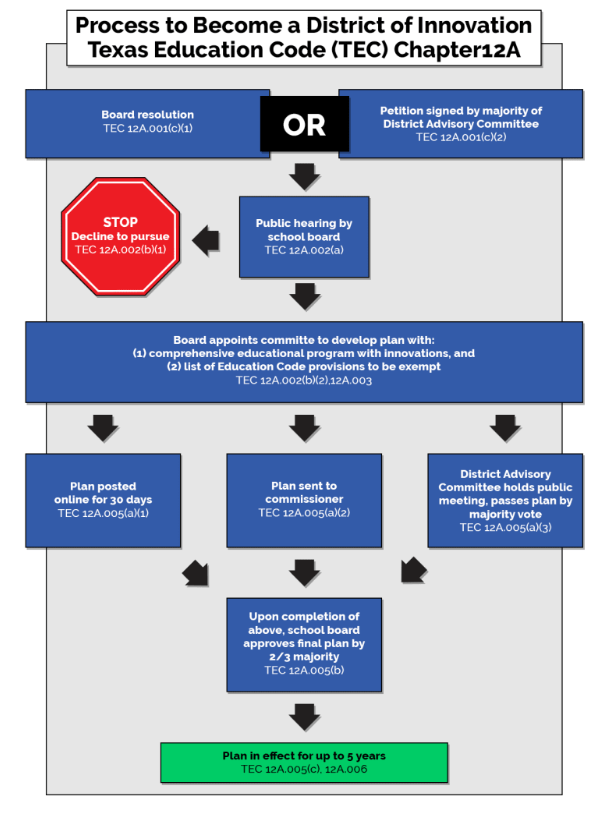Texas is known for many things. The Alamo. Football. Oil. Southern hospitality. Six of the United States’ largest cities are situated throughout the state’s sprawling plains, deserts, beaches, mountains, and valleys. It is a state that has to meet the diverse needs of over 30 million people.
If you talk to education leaders nationwide, they will often say that their state has a lot of local control over education. But everything is bigger in Texas, and that includes how much local control the state allows districts in making decisions that they feel will best meet the needs of their students.
For example, in 2015, Texas passed H.B. 1842, which amended the state education code to introduce a new designation: Districts of Innovation. Districts designated as a District of Innovation (DOI) are granted many of the same flexibilities that are provided to open-enrollment charter schools across the state, all in the name of local control. Under the DOI designation, districts that maintain at least an acceptable accountability rating may create and adopt a local innovation that may typically be prohibited by the state.
Possible exemptions may include:
- Class size requirements
- Start and end dates of the school year
- Various purchasing and contract requirements
The process to become a DOI begins at the district level, with each district board of trustees being required to pass a resolution or secure a signed petition from the majority of their district-level advisory committee to pursue an innovation plan. Once public hearings are held, district board members write a plan that includes the goals they are trying to achieve and which state codes impede those goals and should therefore be waived. Each district then makes its plan available for public feedback and notifies the state commissioner of its intent to adopt a DOI plan, with a two-thirds majority vote from the district board of trustees required to pass. The infographic below provides a detailed overview of the process to become a DOI.
Becoming a District of Innovation

While the state agency does not have authority to approve or deny districts’ plans, districts do not have total carte blanche when applying for innovation designations. Some state and federal requirements still apply, which prevent districts from waiving state assessment and accountability requirements or certain financial regulations. Because there are limits on which regulations districts can waive, the state maintains a necessary level of oversight and accountability, and the state commissioner may revoke or require the district to amend its plan after two consecutive years of unacceptable performance ratings. After three consecutive years of unacceptable performance ratings, the state commissioner is required to terminate a district’s DOI status, further reinforcing the need to maintain assessment and accountability requirements.
While not explicitly designed to encourage schools to reimagine the teaching role, districts across Texas have leveraged the DOI designation to implement policies and strategic staffing models that are normally impossible due to class size requirements or other state laws.
For instance, Ector County Independent School District (ECISD), a large district implementing Opportunity Culture, a strategic staffing model extending the reach of highly effective teachers and therefore necessitating larger class sizes, submitted an innovation plan waiving class size requirements, which allowed for the larger class sizes necessary to effectively implement the model. The designation can also be leveraged in conjunction with other state initiatives, such as the Texas Teacher Incentive Allotment, which provides districts with additional funds of up to $17,000 per teacher to pay for working in leadership or “expanded reach” roles, in which teachers teach more students.
Here is an excerpt from ECISD’s DOI plan, detailing the challenge they are attempting to address and what exemptions are necessary to achieve it.
Ector County District of Innovation Plan
25.112 Class Size
Current Challenges:
- Due to staff vacancies and other factors, ECISD submitted a class size waiver request to the Texas Education Agency (TEA) for 204 PK–4th grade classes above the 22:1 ratio.
- Using Opportunity Culture as a strategic staffing model creates classes over the 22:1 ratio by design.
Benefits, Guidelines and Rationale of Exemption for ECISD:
- Waiving the maximum class size limit will allow ECISD to fully implement the Opportunity Culture strategic staffing model without requesting an exception from TEA in grades PK–4.
- It is not the intent of ECISD to use this portion of the [District of Innovation plan] to increase the student: teacher ratio in every PK–4 class across the district.
Understandably, broad exemptions from state law can have negative impacts on student and educator outcomes, particularly if districts waive certification requirements or other measures that have proven to positively impact learning. While limited research exists exploring the impact of the innovation zones generally, a 2021 analysis of DOI innovation plans across 864 districts in Texas found that districts that received limited regulatory autonomy from the state did not experience significant declines in math or reading achievement. It should be noted that NCTQ is defining “innovation zone” as having structures in place that exempt districts and schools from specific laws or regulations to provide flexibility to innovate. The term has different statutory meaning in Texas. The creation of an “innovation zone” could be an ideal strategy for states that have districts that can develop well-laid-out plans and monitoring by the state. Such districts would be best positioned to explore strategic staffing models with flexibility on state policy.

